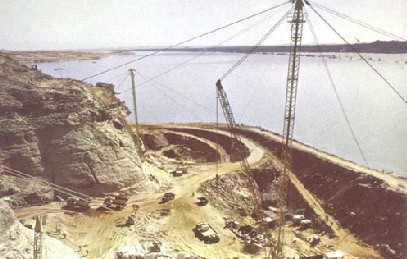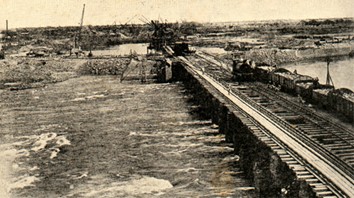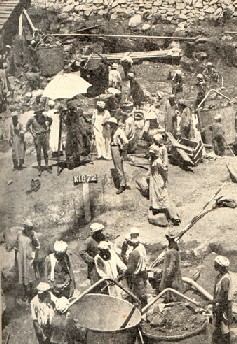|
There
has never been, and probably never will be, a river so
full of romance and history as the River Nile, held
sacred in ancient times as the “Father of Egypt.”
The Nile has intrigued man’s
imagination more than any other river in the world.
Unrivaled in length in the African continent, the great
river is 4145 miles long flowing from beyond Lake
Victoria, through more than half the length of Africa,
to empty its water in the Mediterranean Sea. During its
flow, it twists across dense jungles, haunts of big
game, past the mysterious buildings and stone faces of
ancient Pharaohs who forged the great civilization of
Egypt before joining the sea. On its way, it receives
many smaller rivers, the two most important being the
Blue Nile and the Atbara or Black Nile.
For centuries,
the majestic river defied fearless adventurers in search
of its source. No one knows who first began the search.
Early records of this quest show that it was a restless
Greek Scholar who sailed from his home at Halicarnassus
in the Turkish Coast and toured the civilized lands
around the Mediterranean. An inquisitive man, Herodotus
toured up the Nile all the way to the First Cataract to
see what he could “with his own eyes.” He recorded in
his books a description of the Egyptian temples and
tombs, which he had seen during his travels. Later
records show that a Roman expedition sent by Emperor
Nero, had abandoned its search midway after trying to
find the river’s source. The Arabs who came after them
gave up their search on the swampy marshlands of
Southern Sudan, naming the marshy expanse as “the
Barrier.”
Not until a
century ago, did men probe farther for the river’s
beginning. Notable among them are the names of Dr. David
Livingstone, John Hanning Speke, Richard Francis Burton,
Samuel Baker, and Henry Morton Stanley that stand out
among the greatest figures of the nineteenth century
explorers of Africa, who tried to search for the origin
of the River Nile. It was not until 1937, when an
obscure German explorer by name Dr. Burkhart Waldecker
ended the search and traced the river’s southernmost
source to a tiny spring that bubbled out on a lonely
summit in Burundi. It was the humble birthplace of the
majestic River Nile.
For millenniums,
the wisest men of the Egyptian civilization have been
mystified by the Nile’s annual flood, which watered and
enriched its valley, sustaining generations of Egyptians
and Sudanese in an otherwise arid land. According to Al-Maqrizi,
the fifteenth century Arab historian, when the Arabs
conquered Egypt, Amr ibn al Aas (r.a) the Arab general
leading the Muslim army was told that the Egyptians were
accustomed at the period when the Nile began to rise to
deck a young virgin in gay apparel and throw her into
the river as a sacrifice to gods in order to obtain a
plentiful supply of water to irrigate their crops. The
Arabs soon abolished this barbarous custom; and the Nile
in consequence, did not rise in the least degree during
the space of nearly three months after the usual period
of the commencement of its floods. As a result, the
Egyptians became greatly alarmed and approached Amr ibn
al Aas who was now the Governor of Egypt for advice
thinking that a famine would certainly ensue for not
carrying out the age-old sacrifice.
It is reported
that Amr ibn al-Aas wrote to Khalifa Umar to inform him
what he had done and of the calamity with which Egypt
was threatened, seeking his counsel in this matter. Umar
ibn al-Khattab (r.a) returned a brief answer expressing
his appreciation of Amr’s conduct and desiring him upon
the receipt of his letter, to throw a note, which it
enclosed, into the Nile. The text of the note ran as
follows: From Abdullah Umar, Commander of the Faithful,
to the Nile of Egypt. “If thou flow of thine own accord,
flow not: but if it is Allah, the One God, the Mighty,
who causeth thee to flow, we implore God, the One and
the Mighty to make thee flow.” Amr did as he was
commanded; and it is recorded that the Nile, rose
sixteen cubits in the following night.

The British
scientists examining this phenomenon of flooding in the
late nineteenth century soon found out that it was the
Blue Nile and the Atbara, which were mainly responsible
for the yearly floods. The main river collected an
enormous amount of water from the great equatorial
region around Albert and Victoria Lakes, which passed
through a marshy district where a great deal was lost.
Added to this, the terrific heat in Upper Sudan caused a
high percentage of water to evaporate. As a result, the
Nile reached Khartoum in a constant flow throughout the
year. Here it was joined by the Blue Nile that flowed
from Lake Tsana, and then by the Atbara. Both these
streams flowed through the fertile valley of Ethiopia
bringing a rich deposit of red alluvium, during the
flood season every year. With never failing regularity
the Nile at Aswan would begin to rise in June when the
waters were light green in color, and would gradually
increase until the middle of October, by which time the
river would become a racing flood of reddish tint, owing
to the silt carried by it. After October the flood
receded to its lowest point once again only to repeat
the cycle next June.
This process had
continued uninterrupted for thousands of years. The
rising waters of Nile would spread all over the valley
and submerge the entire area for a period of two months.
After that the flood would subside and the water would
drain off leaving behind the fertile silt, making the
valley fit for the cultivation of crops. As soon as the
engineers realized what was happening, they came to the
conclusion that it was a terrible waste of having the
land irrigated only once a year with so much water to
spare. They turned their thoughts at once to a system of
artificial irrigation by which they could hold back the
excess water generated by the floods in ponds and
spreading it across vast tracts of land through the
canals, as and when it was needed. Systems of primitive
irrigating methods had been in operation for centuries
in Egypt, but there was nothing that was attempted on a
large scale and naturally a start was made in the
richest and most populous part of Egypt, the Nile
Delta.

During the early
part of the eighteenth century, French engineers had
commenced work on a great barrage near Cairo, where the
River Nile branched into two. After working on the dam
for a couple of years the work was abandoned, but the
idea was again revived in 1843. This undertaking was
plagued by problems from its start. Work was done
hurriedly and the foundations of the barrage were
unstable. In 1890, British engineers had to work at
strengthening the dam before it became valuable to the
people of Egypt. Said Pasha who ruled Egypt at that time
is believed to have pushed hard on the work because he
thought by opening the sluices of the dam he would be
able to sweep away any invaders coming to Egypt from the
direction of the Mediterranean.
Similar barrages
varying in height from thirteen to eighteen feet had
been constructed earlier along the Nile at Zifteh, Isna,
and Assiut. At each of these places a great canal
transported water from the dam through its sluices. From
there the water was transferred through smaller canals,
decreasing in size and increasing in numbers into the
surrounding countryside, ending in small ditches to
irrigate the farmlands surrounding the Nile. Since the
canals carry a large amount of water through them, it
became essential to maintain a large supply of water in
reserve throughout the year in barrages built across the
Nile. A regular supply of water throughout the year
ensured the fertility of the soil for the entire year
and as a result the yield of crops went up by leaps and
bounds. The successful function of the barrages to this
end made it necessary to draw the attention of the
engineers to meet the demands of water in Upper Egypt.
A report was
commissioned by the government to draw out an estimate
as to the amount of water that was needed to irrigate
all the cultivable land in both, Upper and Lower Egypt,
during the period of low Nile. In the report, it was
estimated that that twenty-seven million tons of water
per day were required for five months of the year, in
addition to the normal flow of water. In order to secure
this, it would be necessary to construct a dam that was
capable of holding no less than 4000 million tons of
water! Of all the schemes that were proposed, the best
was the construction of a dam at the town of Aswan, at a
site where the Nile tumbled over a rocky slope called
the First Cataract, which would be capable of holding
2500 million tons of water, and this plan was adopted.
No sooner a decision was taken in this regard, a great
hue and cry was raised against this proposal by the
archeologists because the reservoir that would be
created would submerge the prehistoric pharonic temples
built on the islands of Philae for five months in a
year. After careful deliberations, it was decided to
lower the water levels originally proposed by
twenty-five feet and this meant that the dam constructed
would be capable of storing only 1000 million tons of
water.
When the
engineers commenced their work, they had a truly
tremendous task before them. The hills in the
neighborhood of Aswan were made up of red granite and
contained ancient quarries from which stone was taken
during the construction of the Great Pyramids. And that
was the only point in favor of the engineers building
the dam, for this would ensure a plentiful supply of
stone to the builders. During low water the River Nile
ran in five different channels at the site of the dam at
a very rapid pace, and right across these a dam
measuring 1 < miles long had to be built at a height of
67 feet above the river level and in places 130 feet
above the foundation.
After the
preliminary calculations, the next task for the
engineers was to arrange the logistics for carrying out
such a huge task. In March 1898, there sprang up such a
hive of activity that had never been seen in Egypt since
the ancient times when slaves of the Pharaoh dragged
along the great stones for the Pyramids. Nearly a whole
year was taken for the preliminaries, before a start
could be made on the dam itself. During this period the
services of a special staff of engineers, headed by Sir
William Willcocks and Sir Mudroch Macdonald, skilled in
the construction of dams were hired from England, huts
and offices were erected for the workers of the dam,
railway lines were laid to carry cargo to the site, and
thousands of workers were taken into service, along with
hundreds of skilled masons from Italy and were brought
to the site. Finally, everything that was needed to
begin the work on the dam was in place to start the
construction.

First the
engineers had to find a firm bed of rock on which the
massive dam could rest, and although the work on the
islands between the channels was comparatively simple,
the problem was how to excavate in the beds of the
channels through which the water ran so swiftly. An
additional complication was that no work could be
carried for seven months in a year while the river was
in flood. After much deliberation, it was decided that
temporary dams had to be built below the site of the
dam-or “sudds” as they are called in Egypt- to pump out
water and free the ground for the construction of the
dam. By tipping great stones over the end of the
channels the engineers managed to close four of them on
the downstream side during the flood season. As soon as
the work could be resumed after the flood, sudds were
commenced, by piling an enormous number of bags filled
with granite sand across the channels. This work
progressed rapidly, and when the four channels were
safely cut off, pumping was commenced, which rapidly
cleared the water.
As soon as the
channel beds were uncovered the workmen were directed to
remove from the surface all the loose stones and
boulders. Further excavation work had to be done before
a firm base could be found. Pickaxes and dynamite were
used to clear all the unsound rocks in the area. While
this was proceeding, additional sudds were commenced
across the remaining channel. The annual flood of the
River Nile again stopped work on the dam, but not before
800,000 cubic yards of material had been cleared and the
foundations for the dam was laid in all but the western
channel. By the year 1901, work on the great dam was
being carried round the clock and at great speed.
Despite the intense heat workmen toiled relentlessly at
clearing the ground and placing the stone in the heart
of the dam, while the Italian masons were ready with
their trowels on the other side to cement the great
squared blocks. However, the construction of the dam
was not easy as building a solid block of wall. Great
sluice openings measuring 6 feet 6 inches wide,
numbering 180 had to be left in the wall, 140 of them at
a height of 23 feet and the other forty at 12 feet 6
inches. This meant that the dam had to be solid to just
above the level of the riverbed, pierced by great
openings for the next twenty-three feet, and solid again
for the reminder of its height, except that a space had
to be left for the sluice gates to move in. So rapidly
did the work progress that before the flood came again
the great dam had been raised to a height of nearly
fifty feet above the riverbed. |
